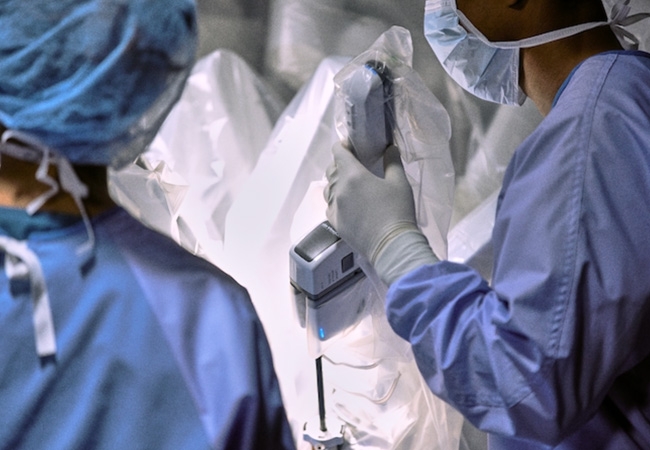New surgical developments in prostate surgery appeared with the frequent use of laser technology. Successful results with popularity created a new method called Holmium Laser Prostatectomy (HoLEP). HoLEP is a totally endoscopic surgical procedure allowing for the removal of the entire prostate tissue. Results of the surgery are similar to those of open old fashion surgical approach.
This procedure enables the removal of grown prostate tissue from its capsule through normal urinary tract. With the help of a special device, the removed prostate tissue is fragmented in the bladder and taken out.
HoLEP (Enucleation of the prostate with Holmium Laser) is the best known laser treatment for benign prostate enlargement; Other methods used in the treatment of benign prostate enlargement are Photoselective Prostate Vaporization (PVP) with Greenlight Laser, Thulium Laser Enucleation of the Prostate (ThuLEP),Thulium Fiber Laser Resection of the Prostate (ThuLRP),Diode Laser Enucleation of the Prostate (DiLEP),Diode Laser Vaporization of the Prostate (DiLVP),Holmium Laser Resection of the Prostate (HoLRP) and Thulium Fiber Laser Enucleation of the Prostate (ThuFLEP).
Due to its many benefits, HoLEP has become the gold standard for prostate enlargement surgery in the United States and Europe over the past decade. Because it requires a high-tech infrastructure, the 120-watt holmium laser used to treat prostate enlargement with the HoLEP Method can only be used in a limited number of centers in our country.
A 120-W Holmium:YAG laser (Pulse 120H, Lumenis Inc.) with 550-m fiber (SlimLine TM 550, Lumenis Inc.) was used as the energy source for HoLEP. This tool has two separate foot pedals for cutting the prostate (enucleation) and stopping bleeding (hemostasis).
Prof Lütfi Tunç organizes live surgery courses in Ankara with the participation of experts from countries where the HoLEP method is widely used, such as Germany, Italy, and England. At the 2016 European Association of Urology - Urotechnology Department (ESUT) congress held in Athens, he performed HoLEP surgery with a live broadcast, which was well received by the attendees. In addition, Prof. Tunc is one of the thirty members of the Holmium Academy who are authorized to provide HoLEP training (mentoring) worldwide.
As with any other surgical procedure, the experience of the surgeon and his team is crucial in HoLEP surgery. This reduces the duration of the procedure and the risk of complications.
Prof. Tunc and his team have successfully treated hundreds of patients with prostate enlargement using HoLEP prostate surgery, and they have experienced the patients' happiness.
Spinal anesthesia is sufficient for prostate enlargement surgery utilizing HoLEP. Through the normal urinary tract, the enlarged prostate tissue is separated from its capsule during this procedure. The prostate tissue that has been pushed into the urinary bladder is cut into small pieces and removed using a specialized instrument.
The widespread use of lasers in urology led to the development of new prostate surgery techniques. Holmium laser enucleation of the prostate (HoLEP) is the method that is gaining in popularity and usage due to the excellent results achieved.
During laser prostate enlargement surgery, all of the prostate tissue is taken out, so there is no probability that the disease will come back. Since lasers are very effective at controlling bleeding, this method is quite safe for patients who must take antiaggregant and anticoagulant medications.
Nerves passing through both sides of the prostate are associated with sexual functions such as erection. Depth of holmium laser within tissue is at least 0.4mm so healthy tissues are not expected to be subjected to any harm. As a result, those patients are not expected to complain about a potential erectile dysfunction.
Recurrence of the disease is not expected because the prostate tissue is completely removed. With the use of laser, HoLEP is also safe for patients who cannot stop anti-aggregant treatment before the surgery.
Lower bleeding risks, shorter hospital stay and faster recovery are the main advantages of HoLEP as patients get rid of urethral catheter in a period shorter than 24 hours and return back to their normal lives. Last but not the least, patients state that they feel like they are back in their 30s.
The same risks associated with anesthesia apply to HoLEP surgery as they do to all other surgeries. Before surgery, the anesthesiologist evaluates each patient to determine how to reduce these risks. Bleeding and infection are risks associated with HoLEP surgery; in these circumstances, open surgery is rarely required. These complications are extremely rare, though.
Around the prostate capsule are nerves that control sexual activity. The process has no effect on the deep healthy tissues because the holmium laser's effect on the tissue is only 0.4 mm. In this way, patients who undergo prostatic enlargement surgery with HoLEP shouldn't experience issues with erectile dysfunction.
The HoLEP method can be used on both large and small prostates because it is not dependent on prostate size. All patients who are under consideration for prostate surgery may be suitable HoLEP candidates.
The cost of laser prostate surgery varies depending on the patient and a few different variables. Prostate size, anticipated operating time, and length of hospital stay are all factors that affect the cost of the procedure because a different laser probe is used for each patient. Therefore, it is important to consider these factors before providing patients with a price.

In addition to prostate surgery, treatments of urinary system (kidney, ureter and bladder) tumors can also be performed with Thulium laser. Suspicious lesions (tumoral areas) in the bladder can be removed as a whole with this laser, which has been developed with the latest technology and has an effect of only 0.2 mm on the tissue.
MORE